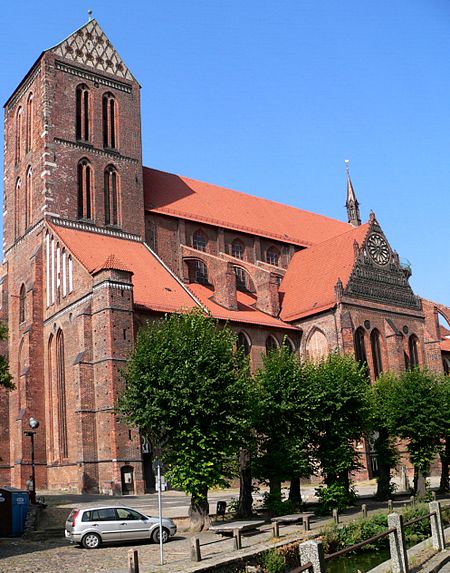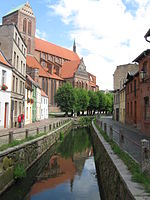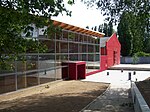Wismar (German pronunciation: [ˈvɪsmaʁ]; Low German: Wismer), officially the Hanseatic City of Wismar (Hansestadt Wismar) is, with around 43,000 inhabitants, the sixth-largest city of the northeastern German state of Mecklenburg-Vorpommern, and the fourth-largest city of Mecklenburg after Rostock, Schwerin and Neubrandenburg. The city was the third-largest port city in former East Germany after Rostock and Stralsund.
Wismar is located on the Bay of Wismar of the Baltic Sea, directly opposite the island of Poel, that separates the Bay of Wismar from the larger Bay of Mecklenburg. The city lies in the middle between the two larger port cities of Lübeck in the west, and Rostock in the east, and the state capital of Schwerin is located south of the city on Lake Schwerin. Wismar lies in the northeastern corner of the Hamburg Metropolitan Region, and is the capital of the district of Northwestern Mecklenburg. The city's natural harbour is protected by a promontory. The uninhabited island of Walfisch, lying between Wismar and the island of Poel, administratively belongs to the borough of Wismar-Wendorf.
It is estimated that Wismar was founded in 1226 under Henry Borwin I, Lord of Mecklenburg from the House of Mecklenburg, a German dynasty of Slavic origin also known as the Obotrites or Niklotides. In 1259, the city became part of the Hanseatic League. Throughout its history, the city has been under control of various German states as well as the Swedish Empire. It was part of Sweden from 1648 until 1803 (de jure until 1903, when Sweden officially renounced its claims to the city), and this Swedish chapter of the city is celebrated annually with a large "Sweden Celebration". From 1815 until 1918, Wismar lay in the Grand Duchy of Mecklenburg-Schwerin and later in the Free State of Mecklenburg-Schwerin.
Wismar is a typical representative of the Hanseatic League with its city-wide Brick Gothic structures and iconic gabled patrician houses and was inscribed on the UNESCO World Heritage List alongside the historical old town of Stralsund in 2002. Wismar is the seat of Hochschule Wismar, a university of applied sciences, one of nine institutions of higher education in Mecklenburg-Vorpommern. With MV Werften Wismar, the city is one of three cruise ship-producing locations of MV Werften (along with Rostock and Stralsund), and the shipyard with its tall white-blue hall is one of the city's largest employers. St. George's, St. Nicholas' and St. Mary's, of which only the tower is left standing, are the three iconic sacred buildings dominating the skyline of Wismar.











